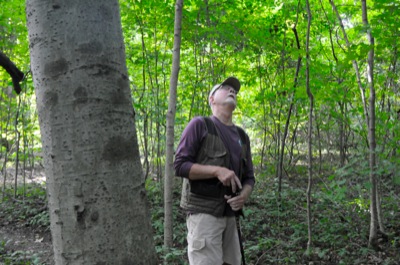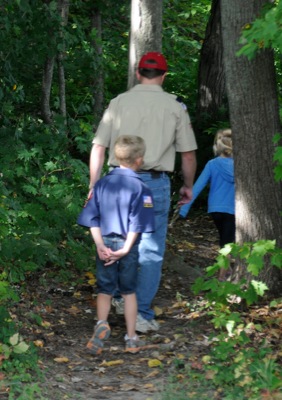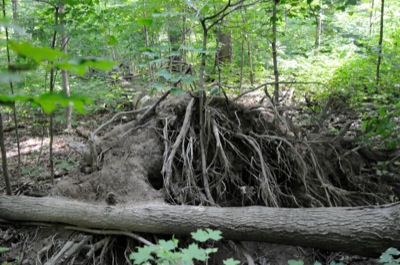Wednesday, October 1st, 2014
Wonders of Baker Woods
Local groundskeeper loves overseeing state nature preserve
By William Kincaid

Photo by William Kincaid/The Daily Standard
Ron Westgerdes, a volunteer of the Ohio Department of Natural Resources Division of Natural Areas and Preserves, points out a 120-foot-tall tree during a recent tour of Baker Woods State Nature Preserve, located just north of Coldwater on St. Anthony Road.
COLDWATER - For the last five years, Ron Westgerdes has regularly traversed the 47 acres of swamp forest known as Baker Woods State Nature Preserve.
The 70-year-old unofficial groundskeeper is a volunteer for the Ohio Department of Natural Resources Division of Natural Areas and Preserves and keeps the primeval forest's 1.25-mile trails clear of debris. He sometimes must reroute the path because of fallen trees or heavily saturated earth.
"As for the volunteer work, I just enjoy being in the woods and enjoy that others get the chance to enjoy it. Mostly, it is a lot more fun than going to a gym for a workout," Westgerdes told the newspaper. "I generally try to check the trails before weekends and especially after windy days and storms."
Westgerdes, who retired from Minster Machine after 34 years, lives half a mile from the protected woods.
"They cut the trails one spring and I discovered them and I asked if I could maintain them and keep them clear," he explained.
Westgerdes gave a tour of the woods on Saturday during the second annual public walk day, organized by the state and the Coldwater tree commission. Families, Boy Scouts and others came out to ramble through the natural setting and enjoy hotdogs at the site north of Coldwater along St. Anthony Road.
"It's pretty well trodden this year; there's been so many people on it that in places it's actually deeper than either side of the trail," Westgerdes said. "It's getting well compacted. Being damp, I think, contributed to that."
The woods was donated to the state in 1992 by the late Lela Mae Baker of Coldwater. It was opened to the public for daily visitation in 2009 and has since attracted naturalists, sight-seers, families and joggers, including a local cross country team.
"The beauty of the trail is it's natural," Westgerdes said.
The trails that wind around the scores of hickory, maple, burr oak, ash, beech and other trees - some centuries-old and scaling heights of more than 125 feet - were established by the state in 2009.
"Some people say it's a figure eight, but truth is, it's like a pair of eyeglasses lying on its side. It's got an 800-foot section in-between two loops, and that section you walk twice," he said.
Westgerdes has since altered sections of the trail that originally went through wet sections of the forest or became obstructed by trees that plummeted to ground.
"There's no creeks in it but the water does flow through the woods ... When they originally laid this out in the spring, it was a dry spring and they made one great big loop like a race track and they went through some of the swampy sections of the woods," he said.
When a large ash tree fell and toppled another tree over the trail, Westgerdes created a new trail around the fallen trees.
"It's a natural cycle of life: Once a big tree dies, it makes room for these little guys to grow up," Coldwater tree commission member Alex Uhlenhake pointed out.
"Stay on the trail and observe, you can't take anything out," Westgerdes said.
The state prohibits the introduction or removal of any organic materials from the preserve, including the gathering of mushrooms or applying of mulch.
"I tried that one year and I caught hell for it," Westgerdes said about putting down mulch. "I thought you could soak up them damp spots but you can't."
Westgerdes uses a grabbing tool to pick up fallen branches on the trail. When he has to cut, he uses a trimming saw.
"I'm not even allowed to use a chainsaw out there," he said. "They don't want me using any power tools as a volunteer. If it's too big, I call them (state officials) and they come and take care of it."
A few summers ago, several trees were knocked down by 60 mph winds.
"It took down about twenty-some trees in this woods, and there were at least six or eight of them that interfered with the trails and that was a mess," he said. "I went in there, and I cut all the foliage off the trees and when they (state officials) finally came in all they had to do was chainsaw the big stuff. But there were places you couldn't even see the trail, it was that bad."
According to an article written by Michelle Comer, district manager of ODNR's Division of Natural Areas and Preserve, white and red oaks dominate the drier areas of the woods while the wet areas consist largely of swamp white and burr oaks and an understory of American elm.
"In the spring, the forest awakens with a carpet of spring wildflowers. In the summer, a cloud of mosquitoes will faithfully follow you on your ramble," she wrote. "If you can tolerate them, it's worth it. The fall, with its blaze of color and rich woodsy smell, will astonish you. Winter brings a beauty all its own - the quiet solitude of a sleeping forest with just footprints in the snow."
Plants used for healing, centuries-old trees and sweet-tasting fruit also can be found in the woods.
"I think a lot of people go for the pawpaw trees," Uhlenhake said.
The pawpaw trees produce a fruit of the same name that tastes much like a mango. But this year, the trees bore little fruit.
Westgerdes during the tour pointed out a vernal pond, which according to Comer is the result of poorly drained soils and shallow depressions.
In the coming weeks, the touch of autumn likely will bring out the multi-colored splendor of the woods.
"In the fall when the leaves start falling on the trail it gets pretty hard to see where the trail actually is to somebody that hasn't been on that trail before, so I usually put up (pink) tape about every 100 feet or so just so the people can stay on the trail," he said.
Baker Woods, like other state natural areas and preserves, is intended for passive recreation, natural observation, research and education and is open to the public one-half hour before sunrise to one-half hour after sunset, according to the state.
Visitors are required to stay on the trails and picnicking is permitted only in areas immediately adjacent to the parking lot.
Vehicles, bicycles, roller blades, skateboards and pets all are prohibited.
For more information, visit naturepreserves.ohiodnr.gov.

Photo by William Kincaid/The Daily Standard
During the second annual public walk day, organized by the state and the Coldwater Tree Commission, families, Boy Scouts and others came out to ramble through the woods and enjoy hotdogs.

Photo by William Kincaid/The Daily Standard
The cycle of life continues at Baker Woods State Nature Preserve as an ash tree lies toppled after being blown over by a recent wind.



